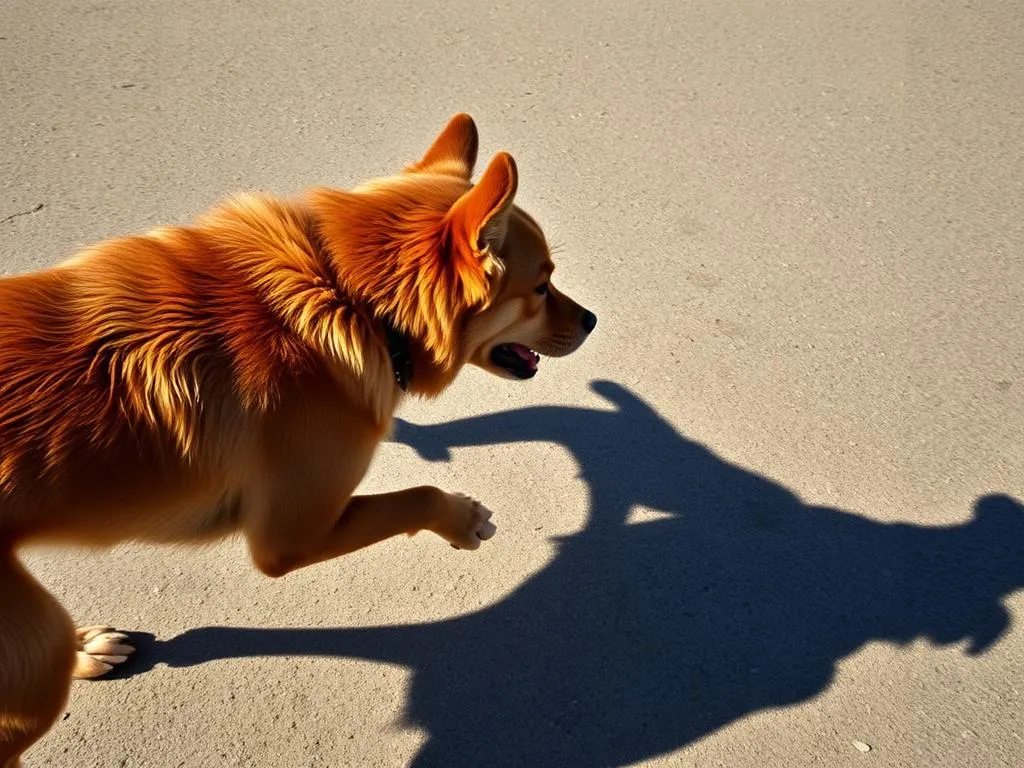
Understanding dog behavior is essential for any pet owner looking to create a harmonious relationship with their furry friend. Dogs, like humans, exhibit a wide range of behaviors that can sometimes seem puzzling. One such behavior that often raises questions is shadow chasing. This article will delve into the reasons behind this intriguing behavior, offering insights on how to manage it effectively.
Understanding Dog Behavior
The Nature of Dog Behavior
Dog behavior can be broadly classified into instinctual and learned behaviors. Instinctual behaviors are innate and typically involve survival skills, while learned behaviors are influenced by experiences and interactions with humans and the environment. For instance, a dog may instinctively chase after a ball due to its prey drive, but it learns through play that this action is encouraged and rewarded.
The interplay of genetics and environment plays a significant role in shaping a dog’s behavior. Some breeds are more predisposed to certain behaviors due to their historical roles, such as herding or hunting. Common behaviors in dogs include barking, digging, chewing, and, of course, chasing shadows.
Communication and Body Language
Dogs primarily communicate through body language, which can tell us a lot about their emotional state. For example, a relaxed dog may have a wagging tail and an open mouth, while a dog that is anxious may exhibit signs like tucked ears or a lowered head. Understanding the difference between playful and anxious behavior is crucial for interpreting why a dog engages in specific actions, including shadow chasing.
Human interaction significantly shapes a dog’s behavior. Dogs learn from their owners what behaviors are acceptable and which are not. Positive reinforcement, such as praise or treats, can encourage desired behaviors, while negative reactions can inadvertently reinforce unwanted actions.
The Phenomenon of Shadow Chasing
What is Shadow Chasing?
Shadow chasing refers to the behavior where dogs pursue shadows, reflections, or moving objects, often in a seemingly playful manner. This behavior can manifest in various ways, such as a dog chasing its own shadow, the shadow of a person, or reflections from shiny surfaces. It can be amusing to watch, but it may also raise concerns for pet owners.
For instance, a dog might dash across the yard trying to catch the shadow cast by a passing cloud or the reflection of a car’s headlights. Such behaviors are not only entertaining but can also reveal underlying instincts and emotional states.
Common Breeds that Exhibit Shadow Chasing
Though any dog can engage in shadow chasing, certain breeds are known for this behavior more than others. Breeds with a strong prey drive or high energy levels, such as Border Collies, Australian Shepherds, and Terriers, may be more prone to chase shadows. These breeds often have an inherent desire to chase and capture moving objects, making them more likely to engage in this behavior.
The characteristics that may predispose certain breeds to shadow chasing include intelligence, high activity levels, and a strong instinct to hunt or herd. Understanding these traits can help owners anticipate and manage this behavior more effectively.
Reasons Why Dogs Chase Shadows
Instinctual Behavior
One of the primary reasons dogs chase shadows is related to their instinctual behavior. Dogs are descendants of wolves, which are natural hunters. The prey drive—the instinct to chase and capture moving objects—is deeply embedded in a dog’s DNA. When a dog sees a shadow moving, it may trigger this instinct, prompting the dog to chase after it as if it were prey.
This ancestral hunting behavior is not limited to shadows; it can also include chasing after anything that moves quickly, such as squirrels or even a child’s toy. Understanding this connection helps explain why some dogs find shadows irresistible.
Environmental Factors
The environment plays a significant role in a dog’s desire to chase shadows. Factors such as light conditions, space, and the presence of moving objects can influence this behavior. For example, bright sunlight can create distinct and moving shadows that may captivate a dog’s attention. Similarly, open spaces like backyards or parks provide ample opportunities for dogs to engage in this behavior.
Moreover, specific play environments can stimulate shadow chasing. Dogs that are frequently exposed to moving lights or reflections—such as those found in urban settings—may be more likely to develop this habit.
Mental Stimulation and Boredom
Another reason dogs chase shadows is related to mental stimulation. Dogs require regular mental and physical exercise to stay healthy and happy. When dogs are bored or lack sufficient stimulation, they may resort to shadow chasing as an outlet for their pent-up energy.
Signs that a dog may need more mental stimulation include excessive barking, digging, or engaging in compulsive behaviors like shadow chasing. Providing varied activities and experiences can help alleviate boredom and redirect a dog’s energy away from unwanted behaviors.
Anxiety and Stress
In some cases, shadow chasing may be a manifestation of underlying anxiety or stress. Dogs that feel anxious may engage in repetitive behaviors as a coping mechanism. If a dog is feeling insecure due to changes in its environment—such as a new home, a new pet, or changes in routine—it may resort to shadow chasing as a way to manage its anxiety.
Signs that shadow chasing may indicate stress include excessive panting, pacing, and a lack of interest in other activities. Recognizing these signs is crucial for addressing the root cause of the behavior rather than just its symptoms.
Managing Shadow Chasing Behavior
Assessing the Behavior
Before attempting to manage shadow chasing behavior, it’s essential to assess the context in which it occurs. Not all shadow chasing is problematic; for some dogs, it may simply be a playful quirk. However, if the behavior becomes excessive or problematic, it may be time to intervene.
Observing when and where the behavior occurs can provide insights into its triggers. Is the dog chasing shadows primarily during playtime? Is it more frequent in certain environments? Such observations can help identify whether the behavior is a result of boredom, anxiety, or simply instinct.
Providing Alternatives
One effective way to manage shadow chasing is by providing alternatives for mental stimulation. Engaging toys, puzzles, and interactive play can redirect a dog’s focus away from shadows. Activities that challenge a dog mentally, such as scent work or training exercises, can also help keep their mind occupied.
In addition to toys, engaging in interactive play with your dog can provide a positive outlet for their energy. Fetch, tug-of-war, or even agility training can be excellent ways to channel energy into more constructive behaviors.
Training Techniques
Implementing training techniques can help curb unwanted shadow chasing behavior. Basic obedience training can lay a foundation for more advanced commands and help establish control over the dog’s actions. Commands such as “leave it” or “come” can be particularly useful in redirecting a dog’s attention away from shadows.
Positive reinforcement strategies—rewarding the dog for desired behaviors—can also be effective. For instance, if a dog begins to chase a shadow, redirecting it with a command and rewarding it for responding can reinforce the idea that focusing on the owner is more rewarding than chasing shadows.
Professional Help
If shadow chasing becomes excessive or compulsive, it may be time to seek professional help. Consulting a veterinarian or an animal behaviorist can provide insights and strategies tailored to your dog’s specific needs. In some cases, behavioral therapies may be recommended to address underlying anxiety or compulsive tendencies.
A professional can help you develop a comprehensive plan that includes training, environmental modifications, and mental stimulation activities to reduce the frequency and intensity of shadow chasing.
Conclusion
Understanding why dogs chase shadows is crucial for any dog owner looking to foster a healthy and positive relationship with their pet. Whether it stems from instinctual behavior, environmental factors, boredom, or anxiety, recognizing the underlying reasons can help you manage this behavior appropriately.
By assessing the behavior, providing alternatives, implementing training techniques, and seeking professional help when necessary, you can effectively address shadow chasing. Remember, responsible pet ownership involves continuous learning about dog behavior, enabling you to create a fulfilling and happy life for both you and your dog.









